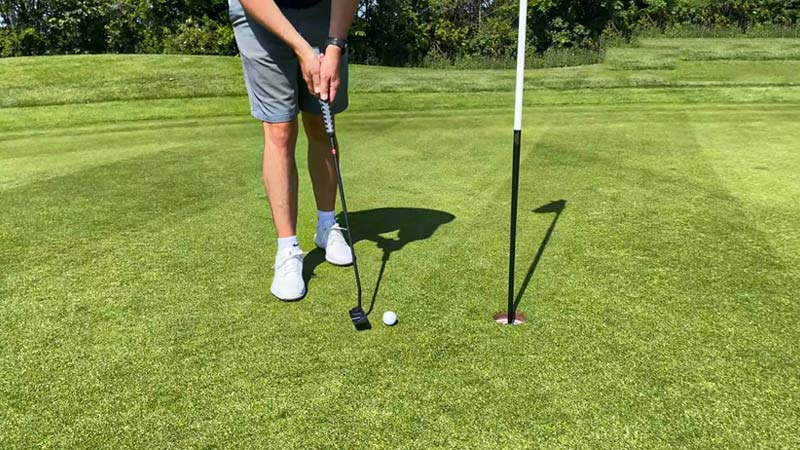Golf, often described as a game of precision and patience, is defined by one elusive number: the score. The golf score, a testament to a player’s skill and strategy, is a subject of intrigue and sometimes frustration.
Whether you’re a seasoned golfer or just teeing off, the concept of what constitutes a good score for 18 holes can be as elusive as a hole-in-one.
In this blog post, we aim to demystify this question and provide guidance to golfers of all levels.
Par, the benchmark against which we measure our performance, is our guiding star. But as the course layout, skill level, and circumstances vary, so do our expectations. A good score for one golfer might be an ordinary day for another.
We’ll explore the factors that influence your definition of a good score, considering skill levels, course difficulty, and the psychological aspects of the game.
So, whether you’re striving to break 100, 90, or even 80, read on to gain insight into what truly makes a score in golf commendable.
The Basics of Golf Scoring

Golf scoring is a fundamental aspect of the game, and understanding it is crucial for players of all skill levels. Here are the basics of golf scoring:
Par
Par is the standard score assigned to each hole on a golf course based on its length and difficulty. It represents the number of strokes an expert golfer is expected to take to complete the hole.
Par values can range from 3 (par-3) to 5 (par-5) strokes for most holes.
Birdie
A birdie is a score that is one stroke under par for a hole. For example, if the par for a hole is 4, scoring a 3 is a birdie.
Bogey
A bogey is a score that is one stroke over par for a hole. For example, if the par for a hole is 4, scoring a 5 is a bogey.
Double Bogey
A double bogey is a score that is two strokes over par for a hole. Scoring a 6 on a par-4 hole, for instance, is a double bogey.
Eagle
An eagle is a score that is two strokes under par for a hole. For example, if the par for a hole is 4, scoring a 2 is an eagle.
Hole-in-One
A hole-in-one, also known as an ace, is when a player completes a hole in just one stroke by holing the ball directly from the tee.
Scorecard
Golfers use scorecards to keep track of their scores for each hole during a round. Scorecards typically include spaces for the hole number, the player’s strokes, and any adjustments for handicap or net scores.
Handicap
The golf handicap system is used to level the playing field among golfers of different skill levels. It allows players to adjust their scores based on their ability, making it possible to compete fairly with others.
Total Score
The total score for a round of golf is the sum of all the strokes taken on each of the 18 holes. Lower total scores indicate better performance.
Tournament Scoring
In competitive golf, tournament scoring often involves stroke play, where the player with the fewest total strokes wins. In match play, the player or team that wins the most holes during the round wins the match.
Gross vs. Net Score
The gross score is the total number of strokes without handicap adjustments, while the net score is the gross score adjusted for a player’s handicap. Net scores are often used in handicap-based competitions.
Course Rating and Slope Rating
Golf courses are rated for difficulty. Course rating provides an estimate of the number of strokes a scratch golfer would take on the course, while slope rating indicates the relative difficulty for a bogey golfer.
Understanding these basic scoring concepts is essential for any golfer. It not only allows you to keep track of your performance but also helps you appreciate the challenges and achievements in this beloved sport.
What Is a Good Score in Golf for 18 Holes?

A good score in golf for 18 holes varies depending on your skill level, the golf course’s difficulty, and your personal goals. Generally, for amateur golfers:
- Bogey Golfer: If you are a bogey golfer (averaging one stroke over par per hole), a good score might be around 90 to 100 strokes for 18 holes on a typical course.
- Intermediate Golfer: For intermediate players (averaging close to par per hole), a good score could be in the 80s.
- Advanced Golfer: Advanced players who can consistently score below par on most holes may consider scores in the 70s as good.
Professional golfers and highly skilled amateurs often aim for scores in the 60s or low 70s to be competitive.
It’s important to remember that what constitutes a good score is subjective and can change based on your skill level and the course’s difficulty.
Instead of comparing your score to others, focus on personal improvement and achieving your own goals in the game.
Factors Influencing What’s Considered a Good Score
Several factors influence what is considered a good score in golf. Understanding these factors can help you assess your performance and set realistic expectations:
Course Difficulty
The golf course’s design, length, and overall difficulty greatly affect what is considered a good score. Courses with longer holes, more hazards, and challenging greens tend to have higher par values.
Par Value
Each hole has a designated par value, which represents the expected number of strokes for an expert golfer to complete the hole. Scoring close to or under par is typically seen as a good performance.
Skill Level
A golfer’s skill level is a significant factor in determining what’s considered a good score. Advanced players will have higher expectations for their scores compared to beginners.
Type of Round
The context of the round also matters. Scores in a casual, relaxed round with friends may differ from those in a tournament or competitive setting.
Personal Goals
Individual goals and expectations play a role. Some golfers aim to consistently break 90 or 80, while others strive to achieve personal bests.
Course Conditions
Weather, course maintenance, and time of day can impact scores. Wind, rain, and course conditions like fast or slow greens can make scoring more challenging.
Psychological Factors
Mental aspects, such as managing pressure and maintaining focus, affect a player’s perception of what’s a good score. Staying calm and confident can lead to better performance.
It’s important to recognize that what constitutes a good score can be subjective and varies from golfer to golfer. Instead of fixating on what others consider good, focus on setting personal goals and enjoying the game at your own pace.
Good Scores for Different Skill Levels

What constitutes a perfect golf score can vary significantly based on a player’s skill level. Here are some general guidelines for good scores for different skill levels:
Beginner Golfer
- A good score for a beginner golfer is often around 100 to 110 strokes for 18 holes on an average course.
- The primary goal for beginners is to enjoy the game, make consistent contact with the ball, and gradually improve their scores over time.
Intermediate Golfer
- Intermediate golfers typically aim for scores in the 80s to 90s for 18 holes.
- Scoring consistently in the 80s is often considered a good achievement for an intermediate player.
- These golfers are working on refining their skills and course management.
Advanced Golfer
- Advanced golfers set higher standards and often strive for scores in the 70s.
- Breaking 80 consistently is considered a good score for an advanced player.
- These golfers focus on precision, course strategy, and fine-tuning their game.
Professional Golfer
- Professional golfers, such as those on the PGA Tour, aim for scores in the low 70s or even in the 60s.
- Consistently scoring under par is essential at the professional level to compete and win tournaments.
- Achieving a sub-70 round is a noteworthy accomplishment.
It’s essential to remember that these are general guidelines, and individual performance can vary widely within each skill level. The key is to set realistic goals based on your abilities and continue to improve over time.
What’s most important in golf is not just the final score but the enjoyment and challenge the game provides.
Considerations for Course Difficulty

When determining what’s considered a good score in golf, course difficulty is a significant consideration. The difficulty of a golf course can vary widely based on several factors. Here are some key considerations:
Course Length
Longer courses tend to be more challenging, requiring golfers to hit the ball with greater distance and accuracy. A good score on a longer course may be higher than on a shorter one.
Hazard Placement
The placement of hazards, such as bunkers, water hazards, and rough, can greatly affect the difficulty of a course. Courses with more hazards make it harder to avoid mistakes.
Green Complexity
The design and speed of the greens are crucial. Fast, undulating greens can be more challenging to put on, and courses with complex green contours require precise approach shots.
Par Value
The par value of the course reflects its expected difficulty. Courses with higher par values are generally more challenging, so a good score may be higher relative to par.
Course Rating and Slope Rating
These ratings, established by golf associations, provide an objective measure of course difficulty.
The course rating estimates how a scratch golfer would perform, while the slope rating indicates the relative difficulty for a bogey golfer. A higher slope rating suggests a more challenging course.
Course Layout
The layout of the course, including doglegs, blind shots, and elevation changes, can impact the challenge level. Courses with more intricate layouts often pose greater challenges.
Weather Conditions
Weather can significantly affect course difficulty. Wind, rain, and extreme temperatures can make scoring more challenging.
Maintenance Conditions
The condition of the course, including fairway and rough grass length, can impact play. A well-maintained course with consistent conditions is generally more playable.
Tee Boxes
Golfers can choose from different tee boxes based on their skill level. Playing from the appropriate tees ensures a fair assessment of the golfer’s abilities.
Mental Factors
The psychological aspects of golf, including dealing with challenging course conditions and maintaining focus, play a crucial role in how a golfer perceives course difficulty and what’s considered a good score.
It’s important to take these considerations into account when assessing your performance on a particular course. What’s considered a good score on one course may not be the same on another due to differences in difficulty.
Ultimately, the goal is to enjoy the challenge and strive for personal improvement, regardless of course difficulty.
FAQs
How many strokes in 18 holes of golf?
In 18 holes of golf, the total number of strokes can vary widely depending on a player’s skill level and the course’s difficulty. Professional golfers often aim for scores in the 60s or 70s, while amateurs may take more strokes.
How many strokes in golf?
The number of strokes in golf varies from one round to another. In professional golf, players aim for lower scores, usually in the 60s or 70s, while amateur golfers typically have higher scores, often above 100 strokes for 18 holes.
Is -1 good in golf?
In golf, a score of -1 is considered good. It signifies that a player has completed the round with one stroke less than par. Achieving under-par scores is a goal for many golfers, especially on challenging courses.
Is 67 a good golf score?
A score of 67 is considered a perfect golf score. It signifies that the player has completed the round in 67 strokes, typically a few strokes under par for the course.
Lower scores are often associated with professional and highly skilled amateur golfers.
How many strokes on a golf course?
The number of strokes on a golf course depends on the course’s design and the player’s skill level.
In a standard round of golf, 18 holes are played, and the total number of strokes varies widely, from less than 100 to over 100 for amateur golfers, while professional golfers aim for scores in the 60s or 70s.
Wrapping Up
In the world of golf, there’s no universal standard for a good score in 18 holes. It’s a dynamic concept, shaped by countless variables.
As our exploration has shown, the definition of a good score depends on your skill level, the challenges presented by the course, and your personal objectives.
Aiming to break par for the professionals, consistently breaking 90 for intermediates, or simply enjoying the game for beginners—these are all valid definitions of golfing success.
Ultimately, the beauty of golf lies not only in the pursuit of an elusive number but in the journey of personal improvement and the joy of each swing.
As you step onto the fairway, remember that the real victory is in the love of the game itself, regardless of the number on your scorecard. Happy golfing!







